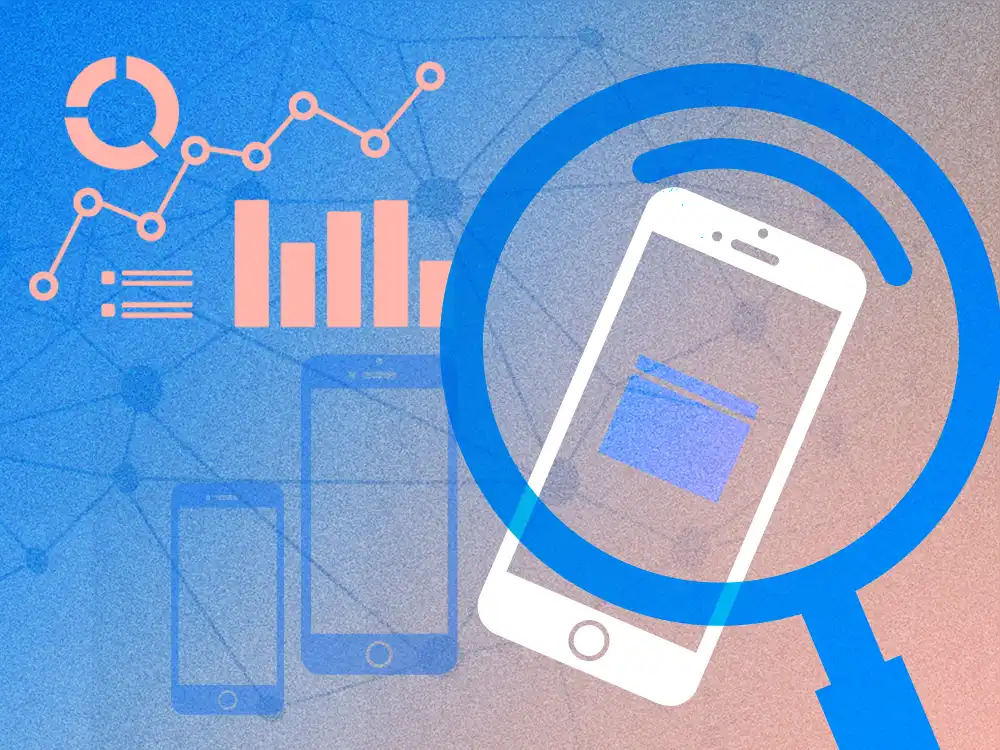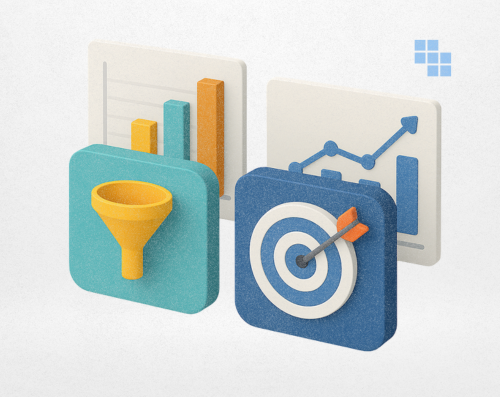Whether your goal is to improve the performance of your app, increase its profitability, understand your customers more, or provide a better customer experience, mobile analytics is your key to the solution. Use this blog to get a grasp on everything mobile analytics offers, how you can use it, and what to look for when choosing a solution.
What is mobile analytics?
Mobile analytics provides businesses insights about the users of their mobile products such as apps, smartphones, and tablets. Mobile analytics, which is actually a subset of a broader category called product analytics, focuses specifically on understanding the behavior of mobile users for the purpose of strategizing how to best to convert, engage, and retain them.
Mobile app analytics tools track, observe, and evaluate user behavior within an app, helping businesses answer questions such as:
- How many total users have downloaded/installed my app?
- Which features of my app are being used most often, and least often?
- How much time do users spend on my app?
- At which points are users experiencing friction in my app, or dropping off?
With up-to-date data from the app to provide answers to these questions, businesses are able to make smart changes to their apps to improve the user experience—ultimately increasing customer engagement and loyalty.
Why are mobile app analytics important?
Building an increasingly data-driven business is currently top of mind for most executives and boards. According to this Forbes article, the combination of increasing technology maturity and the current macro-economic environment is driving organizations to accelerate data monetization and define analytics as a product for many organizations.
Many businesses offer mobile products as one aspect of their offering. While an app may not be the main product that a business offers, the data that the app provides about the ways that customers are interacting with it makes up a very important piece of the customer experience puzzle. Some businesses choose to focus more on their website than on mobile, but both deserve focus. If you truly want to understand your customers’ wants and needs, you need to get to know them in every single channel.
Customers convert at different touchpoints in the customer journey. Any channel that is measured in isolation won’t be able to tell you the whole story. That’s why it’s so important to include mobile analytics and app usage into your analytics strategy along with web analytics, email, social, and other channels.
Mobile app customers are high-value customers to track. These are often your most engaged and most loyal customers, so understanding their usage patterns and behavior can help you foster a long-term relationship with them, resulting in higher lifetime revenue.
Mobile analytics use cases
Here are some key ways that businesses are harnessing mobile analytics to understand their customers more deeply and provide a better mobile customer experience.
To hone app features: Mobile analytics can provide you the data to understand which features your users are engaging with the most, and which ones they engage with the least. This can inform strategic product decision-making. When you’re ready to roll out a new feature, mobile analytics can help you test that feature’s performance with A/B testing or segmented tests, before launching.
To improve retention: Mobile analytics tools can measure your daily active users (DAU) or monthly active users (MAU), as well as how often a specific user engages with an app. You can measure their engagement based on data from their sessions, and analyze retention by looking at how often they return.
To reveal usage trends: Mobile analytics reveals to you the ways that your users are thinking and behaving in your app. By analyzing thousands of different mobile customer journeys, you can spot trends in their behavior. For example, you may notice your app performs differently on different devices, which can drive you to make data-based improvements.
To deliver personalized marketing: App analytics enable you to create personalized customer experiences for users within your app. For example, you can see where exactly in the journey a user dropped off, so that you can adapt your marketing strategy accordingly.
To democratize data: When you combine analytics from your mobile app with analytics from other channels, like website, email, and social, you finally get a complete picture of the different touchpoints that impact your customer’s journey. When this information becomes available via self-service to any team in the organization, your whole organization becomes more data driven.

Customer spotlight: Influence Mobile
Here is an example of the way one Kubit customer used mobile analytics to increase customer conversion on its gaming app.
Background
Influence Mobile connects gaming apps with millions of high-value customers through its rewards program. The company’s success is driven by rapid conversion of its ever-increasing user base of gamers.
Challenge
The onboarding of new customers is a critical time period for Influence Mobile, where the speed that it takes new users to complete registration and start playing significantly impacts the success of every release of its product.
Solution
Kubit provided Influence Mobile a way to closely monitor the onboarding funnel and track key metrics of each of its product releases. With the easy-to-use dashboards, Influence Mobile was able to start tracking every detail of each new launch from the moment it is released.
With Kubit analytics, they were able to identify a key point of friction in their onboarding process, where users had to complete two screens indicating their age and gender. Seeing in Kubit that the rate of fall-off at this point was too high, they made the decision to combine those two screens into one, resulting in higher conversion.
Read the full Influence Mobile case study here.
Key metrics for mobile app analytics
Defining your key metrics for your app should be a reflection of the goals you have set based on the objective of your app. For example, is your objective for your users to make purchases, sign up for a trial, or use your free app daily? Your analytics metrics should provide information to help you achieve your specific goals.
Some of the most common metrics tracked fall under the categories of user acquisition metrics, user engagement metrics, user paths / conversion metrics, and revenue metrics.
Mobile app analytics key metrics, definitions, and examples
| Metric | Definition | Examples |
| USER BEHAVIOR | Analyze all the action events your users take, explicitly (in the UI) or implicitly (backend or third party). With this detailed tracking information, you can get a variety of insights. | App launch Login Page/Screen view Clicks Purchase Subscription renewal Likes |
| USER ENGAGEMENT | Count the occurrences of certain events and compare their ratios through a time series to understand how your users engage with your products over time. | DAU, MAU: Number of unique users per day or month Streams (Events) / DAU: Number of streams per daily active users Revenue/Order: Average purchase amount across multiple order events |
| CONVERSION | Measure the conversion/drop-off rate between the steps of key user flows like registration, checkout, or social loop funnels. | Registration success rate: Percentage of guest users who complete the registration flow Attach rate: Percentage of users who complete the subscription or purchase flow after seeing the paywall |
| RETENTION | Measure how often your users come back and why. | Dn, Wn Retention: Percentage of new users who open the app again on D1/D2, or W1/W2 Subscription retention: Percentage of your subscribers who renew over time |
| USER SEGMENTATION | Segment users by certain criteria to enable dynamic identification and tracking of the behavior of specific groups. Use this data to inform product decisions. | Active viewers: Users who used the app for more than one hour in the last seven days Churned subscribers: Users who didn’t renew their subscriptions Dormant users: Users who didn’t open the app for more than a week |
| ATTRIBUTION | Identify and attribute the sources of new users of your apps. Track and pinpoint which channels your new users come from. | Paid advertisement YouTube/Instagram campaign Social posts Organic installs from app store or your website |
What should you look for in a mobile app analytics tool?
There is no shortage of analytics tools on the market these days, including mobile app analytics tools. It can be difficult to know which one is right for your app and your business objectives. Use these tips as guideposts for choosing one that best suits your needs.
- Features: The tool must offer the features that will deliver the metrics you’re looking for. For example: events, funnels, cohorts, or A/B testing. The features must align with the KPIs of your apps. Keep reading for a deep dive into the most valuable features for mobile app analytics.
- Ease of use: If data democratization is one of your business’s goals, then you need to select analytics tools that make data analysis accessible organization-wide, without requiring a data scientist for interpretation or delivery of reports. Look for a mobile analytics tool that is self-service, so all teams (product, marketing, growth, etc.) can work off of a single source of truth around your mobile app data.
- Pricing and scalability: While pricing is a factor of consideration for any business purchase, consider the return on investment of the tool today, in your business’s current state, and in the future, as you grow. Look for a tool that is scalable and can easily grow with you, as you add more app features, launch new apps, and analyze your website and other digital products along with your app.
- Support: Look for an app, and a business partner, that can provide you with the support you need to ensure your success with mobile app analytics. If this is your first mobile analytics tool, you may want to look for a provider that offers a library of documentation, 24/7 support, or a dedicated account manager.
Top 7 mobile analytics tools and features
- Time series analysis
Visualize metrics over time using time series analysis. You can break down metrics by valuable data points to quickly surface high and low performance. Drill deeper into each data point for granular information. Data can be visualized using line bars, stacked bars, or pie charts.
- Funnel conversion
Understand how customers are converting through key flows within your product. Within a funnel, you can see drop-off and conversion metrics with the ability to break down or segment funnels based on additional data. Data can be visualized using traditional conversion, conversion over time, and frequency before conversion.
- User retention
Learn which users return, or never come back, to utilize core features and how consistently they retain in the following days. You can construct a retention model that fits your needs as well as decide how you want to visualize this critical metric, whether it be retention or churn rates. Analyze your retention model as a standard retention curve, retention over time, or usage intervals.
- Behavioral cohorts
Further analyze individuals contained within your data points. You can create cohorts on the fly or by defining them. Once a cohort is created, you can reuse it as a segment in any analysis, compare two cohorts, or sync them to a third-party tool to drive targeted outreach.
- User paths
Paths are some of the most powerful ways to understand exactly what is happening within the majority of your users’ experiences. Customize a path based on the experience or audience, or break down two paths to see them side-by-side. Paths are visualized using pathing, top paths, and path adjustment to remove noise.
- Third party marketing integrations
The tool should allow you to connect the behavioral cohorts with other marketing tools like Braze, Iterable, etc. to take action on the insights you learned.
Mobile app analytics vs. web analytics?
Mobile analytics and web analytics: both integral in understanding the complete customer journey, and both measurable with a customer analytics platform. But not the same thing. There are a few key differences between mobile app analytics and website analytics, which we’ve summarized in the table below.
| Mobile analytics | Web analytics | |
| Activity | Gathers data from mobile applications using a software development kit to track data and identify users | Collects, analyzes, and reports on the data generated by visitors and users of a website using a tracking code |
| Metrics | User behaviorUser engagementConversionRetentionCohortsDrop-offs | Page viewsSessionsBounce rateTraffic sourceNew visitorsScroll depth |
| Goals | Increase user adoption, engagement, and retention Identify and correct points of friction in customer experience Conduct A/B testing of new features to ensure success Improve segmentation to offer strategic marketing and features to certain segments | Understand who visits your website and where they come from Understand how users interact with your website and if they are taking the actions you desire them to take Identify which pages on your website drive the most traffic Measure how many of your total users convert |
Mobile app analytics best practices
The world of mobile data analytics is vast and full of rich information, so you need a plan and a strategy from the start. Beginning any analytics journey with clear objectives of how analytics will help you achieve your KPIs is fundamental.
As mentioned above, mobile analytics and web analytics work hand in hand, so best practice is to choose a customer analytics solution that can provide insights on both.
Optimal deployment is key to reaping maximum value from product analytics solutions in general. Historically, deployment of these solutions has been plagued with issues such as internal data silos and a lack of technical or engineering resources, making it difficult for organizations to realize significant gains from these solutions in a timely manner. That’s why we believe that the best mobile app analytics solutions should be:
- No-code
- Warehouse-native
- Zero ETL
These solutions access and analyze data directly from its source in real or near-real time. They are integrated directly within an organization’s data warehouse ecosystem, leveraging its architecture for data processing and analytics. In this approach, there is only one single source of truth when it comes to data.
Ready to get started with mobile data analytics?
Kubit’s customer analytics platform enables enterprises to understand their user engagement and optimize their digital products while ensuring data security, compliance, and scalability. With the Kubit analytics platform for mobile apps and websites, companies never have to move their data into silos to gain valuable customer insights. This warehouse-native approach integrates analytics with data warehouses such as Snowflake and Databricks to lower the cost of ownership, free up engineering resources, and deliver more accurate and complete self-service insights.









